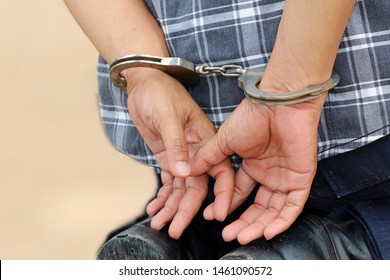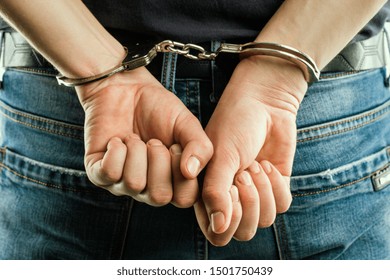Beyond The Cuffs: Understanding What Happens When Someone Is Arrested And Handcuffed
The image of someone being "arrested and handcuffed" is a powerful one, frequently seen in movies, news reports, and increasingly, in viral social media videos. It signifies a loss of freedom, a moment of profound vulnerability, and often, the beginning of a legal process. While handcuffing is a standard procedure meant to ensure safety during an arrest, the circumstances surrounding these moments are rarely simple. Real-world incidents reveal a complex tapestry of legitimate law enforcement actions, alleged misconduct, mistaken identities, and even shocking abuses of power.
This article delves into the various scenarios where individuals find themselves "arrested and handcuffed," drawing on recent events and public accounts to shed light on the often-unseen stories behind this common phrase.
The Standard Procedure vs. Troubling Realities
Typically, handcuffing is an integral part of an arrest, designed to prevent the individual from resisting, escaping, or harming themselves or others. The goal is to secure the person safely. However, the reality on the ground can sometimes deviate sharply from this ideal. We've seen numerous instances where the act of handcuffing becomes a focal point of controversy, raising serious questions about police conduct and individual rights.
- Megan Thee Stallion Hands
- How To Make Blonde Hair Darker
- Holiday Gel Nails 2024
- Jeremiah Vs Conrad
- Face Massage Before And After
When Handcuffs Become Controversial: Allegations of Misconduct
One of the most disturbing aspects highlighted by recent incidents is the alleged use of excessive force against individuals who are already restrained. Handcuffs are meant to incapacitate, not to invite further aggression.
- Excessive Force on Handcuffed Individuals: Several high-profile cases have emerged where law enforcement officers have been accused of assaulting individuals who were already handcuffed and seemingly not resisting. For instance, an officer from the Los Angeles Police Department was removed from field duty after a video showed him punching a man handcuffed during a traffic stop. The man, a 30-year-old, appeared to be handcuffed and not resisting, and his relatives stated he did nothing to provoke the attack. This incident, captured in a bystander video, went viral, sparking outrage and calls for investigation into the LAPD officer's conduct. Similarly, excerpts of body-worn camera footage released by the New York Attorney General’s Office revealed the in-custody beating of a 43-year-old by corrections officers, underscoring the critical need for accountability even within detention facilities.
Wrongful Arrests and Misidentification
Perhaps even more distressing are the cases where individuals are arrested and handcuffed despite being innocent, or where the circumstances of their detention are deeply questionable. The emotional and psychological toll of such experiences can be immense.
- Children Caught in the Crossfire: The vulnerability of children subjected to arrest and handcuffing is particularly poignant. An 11-year-old girl in New York state was filmed being handcuffed on a street corner by authorities after being wrongly identified as a suspect in a car theft. This incident drew outrage from her mother and a prominent civil rights group, with the Onondaga County Sheriff's Office deputies defending their actions by saying she matched a description. Another tragic case involved a six-year-old Florida girl who made headlines after she was arrested and handcuffed in 2019 for allegedly attacking teachers, prompting her family to file a lawsuit against Orlando cops. These incidents highlight the devastating impact of misidentification and the critical need for careful judgment when dealing with minors.
- "What Did I Do, Though?": Bystander video posted on social media often captures the raw confusion and fear of those being arrested. One such video showed two officers arresting an unidentified man who was handcuffed with his hands behind his back, repeatedly asking, "What did I do, though?" This question, simple yet profound, encapsulates the feeling of helplessness and lack of understanding that can accompany a sudden arrest.
- Officer Arrested for Wrongful Arrest: In a twist of irony, a police officer was himself arrested while at a Disney resort in connection to an alleged kidnapping that involved the wrongful arrest of another man. This incident underscores that even those in law enforcement are not immune to the consequences of improper procedures.
High-Profile and Unusual Cases of Handcuffing
The act of handcuffing isn't limited to typical street arrests. It can touch individuals from all walks of life and occur in unexpected settings, sometimes revealing broader societal issues or specific abuses.
- Blonde Hair Fall Colors
- Do Alfie And Emily Get Back Together
- Starbucks Labor Tea
- Tarte Black Friday Sale 2024
- Freaky In The Sheets
Political Figures and Staffers Under Duress
- Union Leader's Arrest: The arrest of a union leader, Huerta, became a public spectacle. Essayli posted an image of him handcuffed and placed in the back of a vehicle, with video evidence showing a brief altercation where he was pushed by a federal official. The criminal complaint noted that "The officer and I then handcuffed HUERTA and arrested him," even as other protesters tried to block the van. This incident highlights the tension that can arise during protests and the visible nature of arrests in such contexts.
- Congressional Aide Detained: Even individuals connected to high-ranking officials are not exempt. An aide to US Representative Jerry Nadler (D-NY) was handcuffed and briefly detained by Department of Homeland Security police in his Manhattan office. New video footage of this incident circulated, prompting concerns about the reach of federal authority and the safety of even federal staffers.
International Incidents and Airport Detentions
The experience of being handcuffed can also transcend national borders, creating diplomatic and human rights concerns.
- Indian Student at US Airport: A video went viral showing an Indian student, Kunal Jain, handcuffed and pinned at a US airport. He was subsequently deported back to India like a "criminal." This incident sparked outrage and discussions about the treatment of international travelers and the discretion exercised by border security officials.
Beyond Law Enforcement: Unacceptable Use of Handcuffs
While most discussions around handcuffing revolve around police actions, there are rare, but deeply disturbing, instances where handcuffs are used by private citizens in ways that constitute abuse.
- Parental Abuse: A particularly egregious case involved a Pennsylvania mother who was arrested after allegedly handcuffing her 11-year-old son to an oil tank in the basement while she went to work. This horrifying act demonstrates a severe misuse of restraint tools, highlighting instances of child abuse that are entirely separate from official law enforcement procedures.
The Human Impact and Public Scrutiny
Behind every instance of someone being "arrested and handcuffed" is a human story. The trauma, confusion, and fear can be profound, especially for those who feel unjustly targeted. The rise of bystander video and social media has fundamentally changed how these incidents are perceived and investigated. What once might have remained a private encounter between an individual and law enforcement is now often instantly public, leading to widespread scrutiny and demands for accountability.
These viral videos serve as crucial evidence, prompting investigations into alleged misconduct, leading to officers being relieved of duties, and sometimes, triggering legal action against departments. They underscore the importance of transparency and the power of public oversight in ensuring that the authority to arrest and handcuff is exercised responsibly and ethically.
Summary
The phrase "arrested and handcuffed" carries significant weight, representing a critical juncture in an individual's life and a powerful exercise of state authority. As explored through various real-world incidents, this act, while often a standard procedure, is fraught with complexities. From allegations of excessive force against restrained individuals by police and corrections officers to the deeply troubling wrongful arrests of children and the high-profile detentions of political figures, the narratives surrounding handcuffing are diverse and often contentious. The role of bystander video and social media has become indispensable in bringing these incidents to light, fostering public scrutiny, and driving calls for greater accountability and adherence to due process. Ultimately, these stories serve as a powerful reminder of the delicate balance between maintaining public order and protecting individual rights and dignity.
Article Recommendations



Detail Author:
- Name : Miss Eda Koelpin I
- Username : aschiller
- Email : corwin.rogelio@hagenes.com
- Birthdate : 1996-07-31
- Address : 7957 Adrien Landing Kavonbury, MS 42849-4653
- Phone : 754.229.2802
- Company : Abernathy, Swaniawski and Hermann
- Job : Gas Compressor Operator
- Bio : Vel nihil itaque consequatur consequatur non. Autem magni deserunt consequuntur facilis et. Recusandae voluptatibus non doloribus amet fuga. Iste aut debitis qui architecto eius et.
Socials
tiktok:
- url : https://tiktok.com/@terrill_real
- username : terrill_real
- bio : Autem voluptate quibusdam sint laborum non error magnam.
- followers : 163
- following : 1463
linkedin:
- url : https://linkedin.com/in/terrill2824
- username : terrill2824
- bio : Non nihil vel voluptatem eaque consectetur.
- followers : 2875
- following : 2810
instagram:
- url : https://instagram.com/terryt
- username : terryt
- bio : Est consequuntur molestias nam quia. Maiores quia incidunt vel deserunt accusamus dolor omnis.
- followers : 1384
- following : 2808
facebook:
- url : https://facebook.com/terry1987
- username : terry1987
- bio : Alias similique dolor nulla asperiores. Enim sequi quam aliquam optio beatae.
- followers : 4085
- following : 26